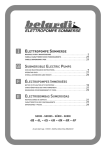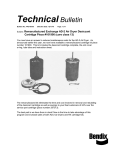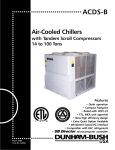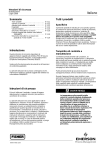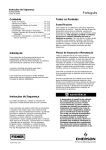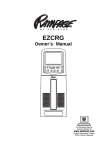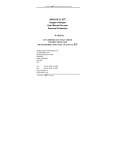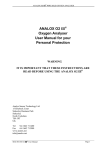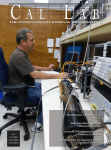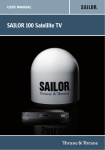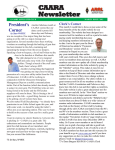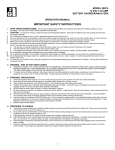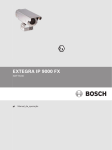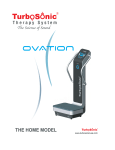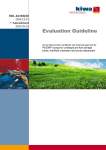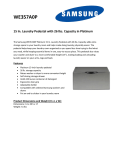Download The HD Service Manual
Transcript
DRY AIR SYSTEMS, INC. 2655 Metro Boulevard Maryland Heights, Missouri 63043 (314) 344-1114 fax (314) 344-0677 HD SERIES DRIERS 1 TABLE OF CONTENTS WHY AN AIR DRYER 3 WHAT IS A DESICCANT AIR DRYER 3 Desiccant Air Dryer General Description 3 Theory of Desiccant Operation Charge Cycle Regeneration Cycle 4 4 4 INSTALLATION INSTRUCTIONS 6 HD2 (10 H.P compressors or less) 6 HD3-HD?? (above 10 H.P compressor) 7 REPLACEMENT SERVICE COMPONENTS PROCEDURE 8 6002K-002 Inlet Valve 8 6002K-001 Purge Valve 9 6002K-003 Desiccant Canister 11 6009X-010 Control Valve (HD2 only) 12 6009X-011 Timer (HD2 only) 13 TESTING THE UNIT 13 DRAWINGS 14 WARRANTY 15 2 WHY AN AIR DRYER Compressor HP 25 50 100 250 500 1000 2000 Total Inlet Cu. Ft. 72,000 144,000 288,000 720,000 1,440,000 2,880,000 5,760,000 Gallons of Water 13.6 27.2 54.3 135.8 271.7 543.4 1,086.60 All air systems trap and contain water moisture and contaminants. The chart illustrates water accumulation during a 12-hour period. Moisture in compressed air systems unchecked harms or destroys delicate pneumatic controls. Water and contamination shortens their life expectancy, reduces reservoir capacity and affects compressor duty cycles. Dry Air Systems offers air drying systems that improve overall system reliability and its related pneumatic controls and devices. The HD series of air dryers are designed for continuous desiccant regeneration with less than 7% of air required for regeneration. Operational cost related to the air drying systems is less than a 75-watt light bulb. These drying systems offer designs with: • • • • Ease of installation Expansion capabilities Particulate filtration Pressure dew point of –40 Fahrenheit WHAT IS A DESICCANT AIR DRYER Desiccant Air Dryer General Description The MVP series of air dryers are models designed to mount vertically after the compressor air reservoir. HD air dryer systems receive warm compressed air that cools, dry and filter contaminates from compressed air before distribution to air systems. Their designs reduce the build up of dirt and moisture protecting complete air systems, pneumatic tools and spray paint booths. 3 HD air systems adapt to air compressors from 3HP up to multiple air compressor systems. Each dryer within a specific system incorporates four pounds of desiccant. A precise continuous regeneration cycle is accomplished without disrupting airflow ensuring a constant cleansing of both the desiccant drying bed and internal filtration. All HD air dryers are constructed of a lightweight aluminum and steel design housing a unique spin-off cartridge. Below the cartridge are four ports: 1) inlet, 2) outlet, 3) control and 4) purge port. Each port has a specific function. The inlet port receives contaminated air from the air compressor. Outlet port directs clean dry air to the air system with a dual function of controlling the regeneration flow rate. Control port receives an air signal from either a MLT (Micro Logic Timer) allowing for the expulsion of water and contaminates through the dryers purge port. Theory of Desiccant Operation Charge Cycle Compressed air enters the air dryer through the inlet port. As the warm air enters the dryer system the air expands; oil and water vapor condense, and accumulate in the sump. The air is directed into a desiccant cartridge passing through a series of internal filters and a cloth bag removing contaminates. Air vapor continues to condense as air travels to the desiccant bed that holds water under pressure. The clean dry air is then directed to the air system through the outlet port. Regeneration Cycle Dryers systematically regenerate when control signals are received from either the MLT by temporarily removing a single dryer off line to begin the regeneration process. An air pressure signal received from the MLT opens the purge valve and closes the air dryer’s inlet and regeneration valves. This action causes a sudden discharge of air through the exhaust port of the dryer. These valves react to air pressure when an air dryer purge port opens. With the inlet valve closed, the regeneration valve is in position to control a timed pressurized back flow of filtered dried air that reenters the desiccant cartridge. During the regeneration cycle, the desiccant bed is depressurized allowing the removal of accumulated moisture from desiccant bed, back flushing and cleaning filters expelling contaminants out the dryers purge port. This completes the regeneration cycle. MLT’s with their specified time intervals close the air dryer purge valve that reacts to the evacuation of air pressure through the exhaust (EXH) port-controlling device. 4 Dry Air Systems, Inc. offers air drying systems to meet the unique requirements from complete plant operation to single units for small or isolated application within an air system. HD2 HD6 Dry Air Systems Inc. 2655 Metro Boulevard Maryland Heights, Missouri 63043 (314) 344-1114 fax (314) 344-0677 email: [email protected] 5 INSTALLATION INSTRUCTIONS HD2 (10 H.P compressors or less) 1. Inspect air compressor lines and fittings for air leaks. 1.1. Repair any air leaks. Replace any damaged lines or components 2. Drain all air system pressure 3. Locate mounting on wall and mark holes 3.1. Note: Desiccant canisters may be removed for easier installation 3.2. Note: Dryers are installed in the vertical position only (canisters up) 4. Mount air dryer system. Install mounting hardware as necessary 5. Connect air line from compressor reservoir to manifold inlet (bottom) of dryer system. 5.1. It is recommended to install a by-pass system for ease of servicing air dryer system 5.2. Note: 2 3/4"npt ports are available for both inlet and outlet. Factory installed plugs may be removed from top and bottom of manifold and be replaced onto front of manifold to facilitate better pipe/hose routing. 6. Connect air line from air dryer manifold (top) to air system 7. Plug MLT timer (6009X-010) into grounded and surge protected 110-volt receptacle 8. Restart air compressor and check for leaks Installation Requirements Dryer system requires at least 80 psi to operate MLT valve Thread sealant must be used on all air connections Dryers are installed in a vertical position only (Canisters up) Hoses may be attached to exhaust ports to direct water drainage Dryers cycle every 4 minutes 6 HD3-HD?? (above 10 H.P compressor) 1. Inspect air compressor lines and fittings for air leaks. 1.1. Repair any air leaks. Replace any damaged lines or components 2. Drain all air system pressure 3. Locate mounting on floor or wall and mark holes 3.1. Note: Desiccant canisters may be removed for easier installation 3.2. Note: Limited adjustment exists left to right by loosening 5/16 SHCS on drier manifold 3.3. Note: Brackets are shipped in floor mount position but may be moved to bolt to bottom of manifold (as shown below) if wall mount is desirable 3.4. Note: Dryers are installed in the vertical position only (canisters up) 4. Mount air dryer system. Install mounting hardware as necessary 5. Connect air line from compressor reservoir to manifold inlet (bottom) 5.1. It is recommended to install a by-pass system for ease of servicing air dryer system 6. Connect air line from air dryer manifold outlet (top) 7. Hook up electrical power 7.1. If unit is supplied with a standard control box, there will be a wall mount dc transformer which needs to be both plugged into the wall as well as into 5/16 dia female plug in bottom of control box 7.2. If unit is shipped with an industrial power supply, a hole must be drilled into the control box and 120vac brought to L1 & L2 terminal points – use adequate protection from potential live electrical circuits! 8. Restart air compressor and check for leaks Installation Requirements Dryer system requires at least 80 psi to operate solenoid valves Thread sealant must be used on all air connections Dryers are installed in a vertical position only (Canisters up) Hoses may be attached to exhaust ports to direct water drainage Dryers cycle every 40 seconds 7 REPLACEMENT SERVICE COMPONENTS PROCEDURE 6002K-002 Inlet Valve Installation Precautions 1. Stop compressor when working on air systems. Never connect or disconnect a hose or line containing air pressure. Never remove a component or a pipe plug unless you are certain all system air pressure has been exhausted. 2. Always wear safety glasses when working with air pressure. Never look directly into air dryer ports. 3. Never exceed recommended working air pressure. 4. Never attempt to disassemble an air dryer until you have read and understood all recommended procedures. Use only proper tools and observe all precautions pertaining to the use of those tools. CAUTION: AIR DRYERS EXHAUST AT HIGH PRESSURE. PROTECTIVE EYEWEAR SHOULD BE WORN WHILE SERVICING. 1. Exhaust/drain air system to zero PSI. If air dryer by-pass was installed, open/close valves as necessary and drain air dryer unit by removing signal line from dryer outlet manifold (1/4” line) 2. Disconnect purge valve (PV-1) ¼” air line from dryer to be serviced. 3. Remove air dryer (6002A-001) from manifold by removing 4 5/16-18 SHCS. 4. Remove air dryer manifold mount pla te (6003D-003) by removing 4 #10-32 SHCS. 5. Remove 8 bolts from bottom cap assembly, remove cap and discard gasket. 6. Remove inlet valve nut, valve stop, valve, spring and discard. 7. Clean cavity area thoroughly. 8. Generously coat (with 6002X-005 silicone grease only) the 2 (small) o-rings surfaces and install on piston. Carefully install valve and spring in cavity with tapered side up. 8 9. Place valve stop on top of valve with concave side down. 10. Lube large o-ring and place on nut. Install flat seal into nut. 11. Install nut and tighten to 50 ft. lb. 12. Place gasket on bottom cap. Locate bottom cap with inlet port directly below outlet port. 13. Re-assemble unit following steps (in reverse) 5 thru 1. 6002K-001 Purge Valve Installation Precautions 1. Stop compressor when working on air systems. Never connect or disconnect a hose or line containing air pressure. Never remove a component or a pipe plug unless you are certain all system air pressure has been exhausted. 2. Always wear safety glasses when working with air pressure. Never look directly into air dryer ports. 3. Never exceed recommended working air pressure. 4. Never attempt to disassemble an air dryer until you have read and understood all recommended procedures. Use only proper tools and observe all precautions pertaining to the use of those tools. CAUTION: AIR DRYERS EXHAUST AT HIGH PRESSURE. PROTECTIVE EYEWEAR SHOULD BE WORN WHILE SERVICING. 9 1. Exhaust/drain air system to zero PSI. If air dryer by-pass was installed, open/close valves as necessary and drain air dryer unit by removing signal line from dryer outlet manifold (1/4” line) 2. Disconnect purge valve (PV-1) ¼” air line from dryer to be serviced. 3. Remove air dryer (6002A-001) from manifold by removing 4 5/16-18 SHCS. 4. Remove air dryer manifold mount plate (6003D-003) by removing 4 #10-32 SHCS. 5. Remove 2 1/4-20 SHCS from adapter (6003D-002). 6. Remove adapter & purge valve operator /seal retainer (6002X-020). 7. Remove seal retainer, purge valve assembly, 4 O-rings and screen. Check to be sure all components are removed and discarded. 8. Clean purge valve cavity. NOTE: Excessive accumulation of oil in the air dryer purge valve indicates compressor may require service. Disassemble entire air dryer and check for blockage within the valve cavities, safety valve and bottom cap cavity. Clean as necessary. 6. Remove all (3) old o-rings from center portion of bolt-on seal retainer. Apply a light coating of (6003X-005) grease on first two new o-rings (1.362 x 103). Install new o-rings on seal retainer. Apply a light coating of grease on the other new O-ring (1.174 x.103). Install on end of seal retainer NOTE: When removing old o-rings be careful not to damage O-ring seats. 7. Apply a light coating of grease to the threads of seal 2 seal retainer bolts. 8. Install new filter screen in purge valve cavity (closed end first). 9. Apply a light coating of (6003X-005) grease to O-ring seat on new purge valve end (1/2 ball end) and install new O-ring (1.364 x.070). 10. Align valve assembly exhaust port with bottom cap exhaust port and install valve assembly. NOTE: Be careful not to dislodge O-ring during valve installation. 11. Reassemble by following steps (in reverse) 6 thru 1. 10 6002K-003 Desiccant Canister CAUTION: DO NOT OVER TIGHTEN CARTRIDGE. HAND TIGHTEN UNTIL GASKET CONTACTS ADAPTOR PLATE AND TURN ADDITIONAL 1/2 TURN ONLY! Installation Precautions 1. Stop compressor when working on air systems. Never connect or disconnect a hose or line containing air pressure. Never remove a component or a pipe plug unless you are certain all system air pressure has been exhausted. 2. Always wear safety glasses when working with air pressure. Never look directly into air dryer ports. 3. Never exceed recommended working air pressure. 4. Never attempt to disassemble an air dryer until you have read and understood all recommended procedures. Use only proper tools and observe all precautions pertaining to the use of those tools. CAUTION: AIR DRYERS EXHAUST AT HIGH PRESSURE. PROTECTIVE EYEWEAR SHOULD BE WORN WHILE SERVICING. Service Instructions 1. 2. 3. 4. Whenever servicing the air dryer, clean and inspect entire unit for any external damage. Remove old cartridge (turn counter-clockwise). Clean dirt/oil from top surface of adaptor plate and threaded stud Remove old O-ring from threaded adaptor. NOTE: Excessive accumulation of oil in the air dryer or air dryer cartridge indicates the compressor may require service. Disassemble entire unit and check for blockage within the valve cavities, safety valve and bottom cap cavity. Drain, clean and replace worn components as necessary. 5. Lubricate new O-ring and install on threaded adaptor. 6. Lubricate the gasket on the new desiccant cartridge. 7. Thread new cartridge onto adaptor (turn clockwise) DO NOT CROSS THREAD NOTE: When gasket contacts adaptor plate, tighten 1/2 turn. DO NOT OVER TIGHTEN or cartridge could be extremely difficult to remove. 11 6009X-010 Control Valve (HD2 only) Installation Precautions 1. Stop compressor when working on air systems. Never connect or disconnect a hose or line containing air pressure. Never remove a component or a pipe plug unless you are certain all system air pressure has been exhausted. 2. Always wear safety glasses when working with air pressure. Never look directly into air dryer ports. 3. Never exceed recommended working air pressure. 4. Never attempt to disassemble an air dryer until you have read and understood all recommended procedures. Use only proper tools and observe all precautions pertaining to the use of those tools. CAUTION: AIR DRYERS EXHAUST AT HIGH PRESSURE. PROTECTIVE EYEWEAR SHOULD BE WORN WHILE SERVICING. 1. Exhaust/drain air system to zero PSI. If air dryer by-pass was installed, open/close valves as necessary and drain air dryer unit by removing signal line from dryer outlet manifold (1/4” line). 2. Remove 1/4” air line from 3 locations at 6009X-010 control valve 6009X-005 tube fittings. 3. Remove 6009X-010C retaining nut from control valve and drop solenoid/timer from unit. Remove timer from solenoid with 1 screw. 4. Remove 6009X-007 #8-32 screws at 3 locations connecting control valve to HD2 manifold body and drop valve. 12 5. Remove fittings from control valve, verify serviceability of fittings and exhaust mufflers. Replace as necessary. It is recommended that (2) 6009X-006 exhaust mufflers be replaced with valve. 6. Install fittings and mufflers on valve and replace in reverse order. 6009X-011 Timer (HD2 only) 1. Remove 6009X-010C retaining nut from control valve and drop solenoid/timer from unit. Remove timer from solenoid with 1 screw. 2. Replace timer and install in reverse order. TESTING THE UNIT 1. Check air tanks for accumulated moisture and drain as required. 2. Start air compressor and allow system pressure to build until cut out pressure. 3. Check all connections for air leaks. NOTE: After air dryers exhausts, air will continue to bleed out of exhaust port until regeneration timed cycles is completed 4. NOTE: A soap solution works very well for locating leaks. 13 DRAWINGS The following drawings are supplied with this manual: 6001A-001 thru –006 6002A-001, 002 6003A-001, 002 6005A-001 6007A-001, 002 6007E-001, 002 6007M-001 6009A-001, 002 6016A-001 XL76 Drawings can be beneficial when referencing maintenance procedures in this manual. System troubleshooting and replacement parts procurement can also be facilitated with the following drawings: 14 WARRANTY For the period of one (1) year, Seller’s sole obligation and Buyer’s sole and exclusive remedy for any defect Product(s) shall be Seller’s reimbursement of the “Warranty Expense”. In addition Seller’s obligation for the Product(s) which are not in conformance with the Seller’s warranty shall be further limited to those product(s) which are promptly returned to Seller after discovery of any alleged defect with Freight prepaid to the warehouse designated by the Seller’s representative and which Product(s) are found by Seller (in the exercise of its sole and exclusive judgment made by Seller experienced and highly skilled personnel) to have been defective in accordance with the warranty. Seller will in no event be liable for any consequential special or contingent damages or expenses arising directly or indirectly from any defects in its goods or from the use thereof, nor is any other person authorized to assume for the seller any such liability or any contrary representations or warranty on behalf of the Seller. In no event shall the Seller be obligated under Seller’s agreement or otherwise in any manner whatsoever for normal wear and tear of any product(s) which in the seller’s sole and exclusive determination have been subjected to accident, abuse, misapplication, improper repair or alteration or maintenance, neglect, excessive operating conditions or for defects resulting from Buyer’s specifications or designs, or otherwise caused by the Buyer, including without limitation defects resulting from Buyer’s manufacture, distribution, sale or promotion of its own product. Seller expressly disclaims any implied or expressed warranty of fitness for a particular purpose. It is understood that such products are warranted to be fit for their ordinary intended use. Dry Air Systems, Inc. 2655 Metro Boulevard Maryland Heights, Missouri 63043 Telephone: 314 344-1114 Fax: 314 344-0677 www.dry-air-systems.com 15
















